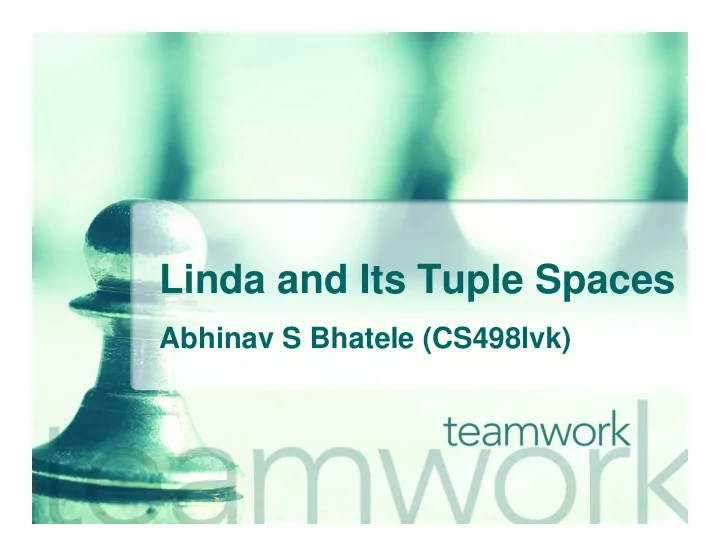

Linda and Its Tuple Spaces Abhinav S Bhatele (CS498lvk)
Introduction It is essentially a shared-memory programming model based on tuple-spaces Only cares about process creation and co- ordination How and what the process computes is a black box to the model A base language with the addition of the tuple operations yields a parallel programming ‘dialect’
Tuple Spaces A tuple is a series of typed fields, for example (“a string”, 15.01, 17, “another string”) Processes share a tuple space between them which has tuples floating in it A tuple can be a simple ‘data’ tuple which can be read and/or removed It can be a ‘live’ tuple which carries out some computation of its own
The model It is based on generative communication A process wishing to send data to another creates a tuple and sets it adrift in the tuple space A process looking for data tries to match tuples in the tuple space with its own If a new process is required for a computation, the parent process releases a live tuple in the tuple space
Tuple Operations To create/ send tuples out – send a data tuple into the tuple space eval – send a live tuple into the tuple space which gets evaluated into a ‘data’ tuple To read/ receive tuples in – read and remove a tuple from the tuple space rd – simply read a tuple from the tuple space
Implications of this model Communication and process creation are two facets of the same operation Data is exchanged in the form of persistent objects and not transient messages It promotes an uncoupled programming style – the senders and receivers need not know about each other
Examples Matching a tuple to get data – out(“a string”, 15.01, 17, “another string”) in(“a string”, ? f, ? i, “another string”) Creating data structures out of tuples – (“V”, 1, FirstElt) (“V”, 2, SecondElt) (“V”, 3, ThirdElt) Change the ith element – in(“V”, i, ? OldVal) out(“V”, i, NewVal)
Dining Philosopher’s Problem phil(i) int i; { while(l) { think(); in(“room ticket”); in(“chopstick”, i); in(“chopstick”, (i+l)%Num); eat(); out(“chopstick”, i); out(“chopstick”, (i+i)%Num); out(“room ticket”); } }
Server-Clients server() { int index = 1; . . . while(1) { in("request", index, ? req); . . . out("response", index++, response); } } client() { int index; . . . in("server index", ? index); out("server index", index+l); . . . out("request", index, request); in("response", index, ? response); . . . }
References 1 . Sudhir Ahuja, Nicholas Carriero and David Gelernter, Linda and Friends , IEEE Computer, Aug. 1986 2. Nicholas Carriero and David Gelernter, Linda in Context , Communications of the ACM, Vol. 32, No. 4, April 1989 3. L. V. Kale, Technical Correspondence on Linda in Context, Communications of the ACM, Vol. 32, No. 10, Oct. 1989, pp. 1252-1253. 4. Nicholas Carriero and David Gelernter, How to Write Parallel Programs: A Guide to the Perplexed , ACM Computing Surveys, Vol. 21, No. 3, Sept. 1989 5. Nicholas Carriero and David Gelernter, How to Write Parallel Programs: A First Course
Thank you!
Recommend
More recommend